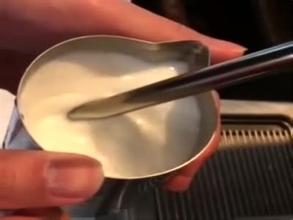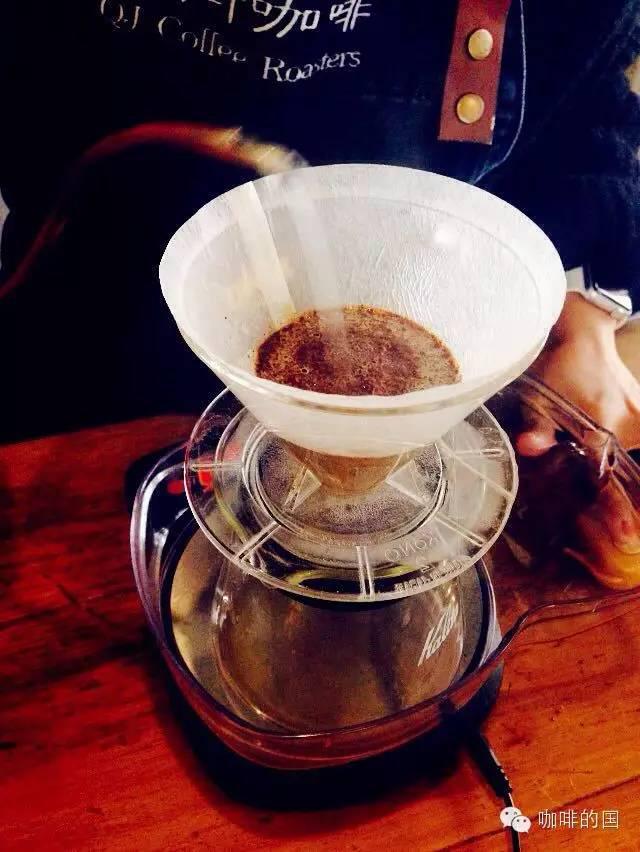Italian Coffee making course: detailed explanation and Correction of the problem of Milk bubbling
Prepare knowledge
Understand the correct operation process of the coffee machine steam system, understand the purpose of the empty steam pipe before and after the milk foam, understand the importance of towels and cleaning in coffee making. Learn how to touch the milk surface with the nozzle, the position of the selected point, and the depth of the selected point.
Two temperature problems
One is the temperature at which the foam starts and ends, and the other is the temperature at which the foam is made. These two temperatures are very important for beginners, which is directly related to whether the principle of milk foam is mastered. First of all, foaming, milk is initially cold (preferably fully refrigerated at 5 ° C), which can extend the foaming time, so that it can foam fully fine foam, and then open the steam valve to foam the milk. Foaming to the same temperature as our human body (feel neither cold nor hot), foaming cut-off. Next, the temperature at which the frothing stops. Let me just say what this temperature feels like on the hand. This temperature is hot when we feel it with our hands (in continuous heating), but it can last for two or three seconds; when the temperature is reached, stop heating (stop heating the rear end feels very hot in the hand, but it can be held).
In some places, thermometer is used to measure. I think this teaching method is not good. Technology is something that needs people's heart to understand. It is not very beneficial to improve people's own technology with the help of external forces. Xiaohan thinks scientific measurement is also good, traditional Chinese medicine is very difficult to pass on.
angle problem
Recognize a dead angle where a frothing tub comes into contact with the steam pipe of a coffee machine. Read a lot of domestic and foreign barista operation to play milk foam, plus their own constant attempts, found that there is a dead angle to play milk foam, just like playing video games, some dead angles are bullets can not hit you, but you can hit others. This angle is very troublesome to say in words, probably the cylinder mouth of the flower cylinder must be lifted, and the cylinder body should be inclined according to the rotation direction of the milk foam.
vortex problem
The role of the vortex is to foam out of the coarse foam through the vortex pulled to the surface below, so that the surface clean. Vortices have many states, and each one needs to be observed and remembered. This is a very deep point, I simply point it, to have a vortex, steam pipe nozzle can not be too deep under the milk.
The problem of drawing cylinder movement
The nozzle is in good contact with the milk surface, that is, open the steam valve. At this time, the flower pulling cylinder moves down very slowly, and you will hear the "eat" steam and milk "shear"(about shear force, when discussing the principle of milk foaming later, talk slowly!) The sound emitted is commonly known as "intake sound". Air intake to human body temperature.
It can't appear again, otherwise, there will be particularly large coarse bubbles on the surface. At this time, move the pull cylinder up a little (only one point, this is very important, many people understand as continuous upward movement, this is very wrong), let the steam nozzle leave the shear surface, so as not to hear the "eat" sound. At this time, by adjusting the angle of the pull cylinder, remember that it is the angle, not the position of the nozzle and the surface (very small angle adjustment), find the vortex, pull the coarse foam of the foaming stage off the surface, and continue to the temperature until the temperature reaches the hot temperature.
steam quantity problem
I often see such descriptions in some materials: when making milk foam, the nozzle will open the steam valve as soon as it contacts the milk surface. I don't quite agree with this (except for the two-stage steam valve, because there is no way to control the steam volume, here I refer to the mainstream rotary valve). In fact, this statement is not too big a problem, but as a beginner, the weight of the hand is no way to control, the valve button is often screwed slip wire. Even coffee lovers, I think it's best not to use this philosophy to operate steam valves.
Back to the topic, let's talk about air pressure. After the pressure has built up in the boiler, we open the steam valve, and steam is sprayed out at this pressure no matter how much it is opened. It's just a little gas, not a little pressure. I suggest that you just open the valve to the extent that you can foam properly, there is no need to fully open it. If you accept this theory, the valve of your coffee machine will live longer. If you accept this view, I will talk about this professional habit formation method. For example, your coffee machine only needs to be turned three times in the open direction (remember, it is three times, not three turns) to be able to emit enough steam for foaming milk, so please always use this method to operate your coffee machine steam valve. Three on, three off. Of course, if two or four strokes is enough steam, follow the above method, and so on. This valve will no longer appear too tight or open to slip wire such a situation, congratulations on the longevity of your valve!

Slaughter-squealing problem
Milk does not foam this process, or very little foam, will produce this sound. The direct cause is that the nozzle is too deep below the surface of the milk. The way to avoid it is to move the pull jar down so that the nozzle does not penetrate too far into the milk surface, and the sound will disappear immediately, in exchange for the "eat" sound we want to hear.
Steam control force problem
No matter how much air pressure is used (in the allowable range of boiler, personal understanding: 0.8-1.2bar), milk bubbles of very good quality can be produced. First establish a premise: use a 600ml medium pull flower jar (old style), hit a jar full of milk foam, make WBC standard two cups of cappuccino with milk foam thickness of 1cm. This problem refers to the foam distribution problem, that is, how to make the foam thickness of two cups of cappuccino consistent. As any of us experienced operators know, there are a few tricks to do this. This trick is not difficult to master, but you must have a deep understanding of the state of the foam in the tank.
Foam control problem
Mainly includes the following aspects: First, the degree of foam. The degree of foaming is one of the most difficult controls to practice. This control requires the operator to have a strong understanding of the principle of foaming milk. The simplest and most feasible control method is: stronger than the middle, stronger than the bottom. How do you understand this? The closer the nozzle is to the middle of the flower cylinder (but try not to be in the middle point, otherwise it cannot be controlled), the more foam, the stronger; the closer it is to the cylinder wall (but not too close to the cylinder wall, which will affect the intake), the less the amount of milk foam. The closer the nozzle gets to the liquid surface before the first temperature is reached, the more bubbles there are. And vice versa! What is the use of this control we have practiced? As mentioned above, there are several standards for making milk foam, one of which is to make as many milk bubbles as you want; if you want to make seven full points, you will never make nine full points; if you make a cup of product, you will never make two cups of milk foam; the cappuccino made each time must be consistent in terms of milk foam quality.
In this control force exercise, there is a three-point theory in it (see picture), these three points are: cylinder mouth, cylinder handle and nozzle, these three points are on a straight line, by adjusting the distance between point 1 and point 2, to achieve the control of milk foam degree. The second is the cleanliness of the foam surface. This is a relatively easy exercise in control, as we discussed earlier with regard to the frothing corner problem. Although the understanding of milk foam to a certain extent, the angle problem is no longer important, but for beginners or operators who have not yet understood the principle of milk foaming, this angle should still be mastered. This angle is very interesting, in the competition, the milk bubble angle of many champions at home and abroad is like this, because it has no way to use words to say, I also can not help you understand together, then please go to find some good milk bubble video to see, online random search can find, if you have not found, then wait for the author's book published when buying a book to see, I will make a video, I hope to solve this matter.
Here, by the way, a way to watch the video, do not look at the inside of the flower cylinder, the internal diagram I have drawn, mainly look at the relationship between the flower cylinder and the coffee machine, and the steam pipe. Keep looking, keep looking, until you find something. By the way, there is also one thing, that is, some books on coffee from Taiwan that are circulating in a small range in China also have a misleading effect on this issue. Before saying this misleading, I declare that I have absorbed a lot of useful coffee information and learned a lot of methods in such books. Thank you to the authors here! Now say misleading, these books in the diagram, a lot of is to pull flower jar flat, this is not suitable for beginners, personal opinion: do not imitate!
source: network
Important Notice :
前街咖啡 FrontStreet Coffee has moved to new addredd:
FrontStreet Coffee Address: 315,Donghua East Road,GuangZhou
Tel:020 38364473
- Prev

The way of making espresso: an introduction to the relationship between foam and flower drawing and the details of production.
Whether the flower is beautiful or not, the key factor is the milk bubble. in fact, how to dispose of the milk foam and the flower in the United States is a kind of feeling, the whole process is the first step of dancing and beating the milk foam with the feeling. First of all, understand the correct operation flow of the coffee machine steam system, understand the purpose of the empty steam pipe before and after foam, understand the towels and casually clean in the coffee system.
- Next

Changes in the roasting of coffee beans: why do coffee beans turn brown after baking? Why is there an aroma?
Coffee color change factors: coffee beans are light green, roasted will turn brown. This baking characteristic brown mainly comes from the brown pigment produced by oligosaccharins, amino acids and chlorogenic acids. The so-called brown pigment does not refer to a color or ingredient, but a general term for the many ingredients that make coffee different colors. Raw beans will gradually change color during baking.
Related
- What is the meaning of lactic acid fermentation with coffee bean treatment?
- How to judge the state of foam by sound?
- How does the latte pull out the unicorn pattern? Come to get for a little trick to improve the flower pull!
- Will flower pulling affect the taste of the latte?
- Do you know the history of coffee?
- The difference between honey treatment and sun washing what is raisin honey treatment?
- What kind of milk can a novice use to make coffee foam to keep the foam longer? The correct method and skills of milking tutorial sharing
- Why do washed coffee beans taste sour? Flavor characteristics of washed Coffee
- Introduction to the skill of how to practice the size and height of water injection around the circle of hand-brewed coffee
- How do beginners practice coffee flower drawing from scratch?

